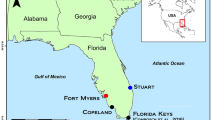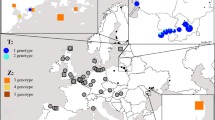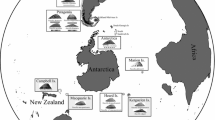Abstract
From a geographical survey of allozyme variation, a history of repeated trans-Arctic invasions since the Plio-Pleistocene is suggested for circumboreal bivalves of the Macoma balthica complex. A principal genetic subdivision, involving several nearly diagnostic loci and Nei's distance D=0.6, distinguishes the clams of the NE Pacific from those of the NE Atlantic. The Pacific taxon is however also present in Europe, in disjunct isolates in the Baltic Sea and White Sea basins. Nevertheless, these populations have marked Atlantic introgressive elements in their gene pools (ca. 30%). Two further population types are recognized, one in the St. Lawrence estuary, Quebec, the other in Varangerfjorden, NE Norway; the latter appears a mixture of Pacific and Atlantic components in almost equal proportions, in local genetic equilibrium (a hybrid swarm). Populations in temperate North America fall outside the circumboreal M. balthica complex discussed here (D=1.0), and are referred to M. petalum. In a scenario of the history and evolution of the M. balthica complex and the similarly subdivided Mytilus edulis complex, the divergence between Pacific and Atlantic taxa started after an initial introduction of Pacific ancestors to the Atlantic basin, enabled by the Pliocene opening of the Bering Strait. During the Pleistocene and Holocene, the ocean basins were, for the most part, effectively isolated, but occasional re-invasions have taken place, causing secondary contacts of the diverged bivalve types on the Atlantic coasts. The recently re-invaded Pacific taxa in northern Europe now seem to thrive only in the extreme marginal environments. Exact dating of the re-invasions is not possible from current data. Apart from the divergence through isolation, hybridization and introgression have significantly molded the present affinities within the M. balthica complex. A formal taxonomic treatment of reticulate and hybridizing lineages is problematic; yet to recognize the evolutionary and systematic diversity within the M. balthica complex, a subspecies distinction between the NE Atlantic clams and those from the Pacific, Baltic and White Sea basins is suggested.



Similar content being viewed by others
References
Bermingham E, Lessios HA (1993) Rate variation of protein and mitochondrial DNA evolution as revealed by sea urchins separated by the Isthmus of Panama. Proc Natl Acad Sci USA 90:2734–2738
Bert TM (1986) Speciation in western Atlantic stone crabs (genus Menippe)—the role of geological processes and climatic events in the formation and distribution of species. Mar Biol 93:157–170
Björck S (1995) A review of the history of the Baltic Sea, 13.0–8.0 ka BP. Quat Int 27:19–40
Borsa P, Daguin C, Ramos Caetano S, Bonhomme F (1999) Nuclear-DNA evidence that northeastern Atlantic Mytilus trossulus mussels carry M. edulis genes. J Moll Stud 65:504–507
Carlton JT, Geller JB (1993) Ecological roulette—the global transport of nonindigenous marine organisms. Science 261:78–82
Coan EV, Scott PV, Bernard FR (2000) Bivalve seashells of western North America. Santa Barbara Museum of Natural History, Santa Barbara
Collins TM, Frazer K, Palmer AR, Vermeij GJ, Brown WM (1996) Evolutionary history of Northern Hemisphere Nucella (Gastropoda, Muricidae): molecular, morphological, ecological, and paleontological evidence. Evolution 50:2287–2304
Cunningham CW, Collins TM (1994) Developing model systems for molecular biogeography: vicariance and interchange in marine invertebrates. In: Schierwater B, Streit B, Wagner GP, DeSalle R (eds) Molecular ecology and evolution: approaches and applications. Birkhäuser, Basel, pp 405–433
da Costa EM (1778) Historia naturalis testaceorum Britanniae, or, the British Conchology. London
Durham JW, MacNeil FS (1967) Cenozoic migrations of marine invertebrates through the Bering Strait region. In: Hopkins DM (ed) The Bering Land Bridge. Stanford University Press, Stanford, Calif., pp 326–349
Ekman S (1953) Zoogeography of the sea. Sidgwick and Jackson, London
Faustova MA (1984) Late Pleistocene glaciation of European USSR. In: Velichko AA (ed) Late Quaternary environments of the Soviet Union. Longman, London, pp 3–12
Geller JB (1999) Decline of a native mussel masked by sibling species invasion. Conserv Biol 13:661–664
Gibbard PL, West RG, Zagwijn WH, et al (1991) Early and early Middle Pleistocene correlations in the southern North Sea basin. Quat Sci Rev 10:23–52
Grant WS (1986) Biochemical genetic divergence between Atlantic, Clupea harengus, and Pacific, C. pallasi, herring. Copeia 1986:714–719
Grant WS (1987) Genetic divergence between congeneric Atlantic and Pacific Ocean fishes. In: Ryman N, Utter F (eds) Population genetics and fishery management. Washington University Press, Seattle, pp 225–246
Hummel H, Bogaards R, Bek T, et al (1997) Sensitivity to stress in the bivalve Macoma balthica from the most northern (Arctic) to the most southern (French) populations: low sensitivity in Arctic populations because of genetic adaptations? Hydrobiologia 355:127–138
Hummel H, Sokolowski A, Bogaards R, Wolowicz M (2000) Ecophysiological and genetic traits of the Baltic clam Macoma balthica in the Baltic: differences between populations in the Gdansk Bay due to acclimatization or genetic adaptation. Int Rev Hydrobiol 85:621–637
Hummel H, Colucci P, Bogaards RH, Strelkov P (2001) Genetic traits in the bivalve Mytilus from Europe, with an emphasis on Arctic populations. Polar Biol 24:44–52
Jørstad KE, Dahle G, Paulsen OI (1994) Genetic comparison between Pacific herring (Clupea pallasi) and a Norwegian fjord stock of Atlantic herring (Clupea harengus). Can J Fish Aquat Sci 51[Suppl 1]:233–239
Leppäkoski E, Olenin S (2000) Xenodiversity of the European brackish water seas: the North American contribution. In: Pederson J (ed) Marine bioinvasions. MIT, Cambridge, Mass., pp 107–119
Lubinsky I (1980) Marine bivalve molluscs of the Canadian central and eastern Arctic: faunal composition and zoogeography. Can Bull Fish Aquat Sci 207:1–111
McDonald JH, Koehn RK (1988) The mussels Mytilus galloprovincialis and M. trossulus on the Pacific coast of North America. Mar Biol 99:111–118
McDonald JH, Seed R, Koehn RK (1991) Allozymes and morphometric characters of three species of Mytilus in the northern and southern hemispheres. Mar Biol 111:323–333
MacNeil FS (1965) Evolution and distribution of the genus Mya, and Tertiary migrations of Mollusca. Prof Pap US Geol Surv 483-G:1–51
Meehan BW (1985) A genetic comparison of Macoma balthica (Bivalvia: Telinidae) from the eastern and western North Atlantic Ocean. Mar Ecol Prog Ser 28:69–76
Meehan BW, Carlton JT, Wenne R (1989) Genetic affinities of the bivalve Macoma balthica from the Pacific coast of North America: evidence for recent introduction and historical distribution. Mar Biol 102:235–241
Meijer T (1993) Stratigraphical notes on Macoma (Bivalvia) in the southern part of the North Sea basin and some remarks on the arrival of Pacific species. Scr Geol Spec Issues 2:297–312
Nei M (1987) Molecular evolutionary genetics. Columbia University Press, New York
Norton PEP, Spaink G (1973) The earliest occurrence of Macoma balthica (L.) as a fossil in the North Sea deposits. Malacologia 14:33–37
Palumbi SR, Kessing BD (1991) Population biology of the transarctic exchange—mtDNA sequence similarity between Pacific and Atlantic sea-urchins. Evolution 45:1790–1805
Petersen KS (1986) An outline on the present stage of study on Late Quaternary marine molluscs in the Nordic realm. Striae 24:39–45
Quesada H, Wenne R, Skibinski DOF (1999) Interspecies transfer of female mitochondrial DNA is coupled with role-reversals and departure from neutrality in the mussel Mytilus trossulus. Mol Biol Evol 16:655–665
Rawson PD, Hilbish TJ (1995) Evolutionary relationships among the male and female lineages in the Mytilus edulis species complex. Mol Biol Evol 12:893–901
Raymond M, Rousset F (1995) GENEPOP (version 1.2): population genetics software for exact tests and ecumenicism. J Hered 86:248–249
Reid DG (1990) Trans-Arctic migration and speciation induced by climatic change: the biogeography of Littorina (Mollusca: Gastropoda). Bull Mar Sci 47:35–49
Riginos C, Sukhdeo K, Cunningham CW (2002) Evidence for selection at multiple allozyme loci across a mussel hybrid zone. Mol Biol Evol 19:347–351
Rohlf FJ (1990) NTSYS-pc. Numerical taxonomy and multivariate analysis system. Exeter Software, Setauket, N.Y.
Sarver SK, Landrum MC, Foltz DW (1992) Genetics and taxonomy of ribbed mussels (Geukensia spp.). Mar Biol 113:385–390
Seed R (1992) Systematics evolution and distribution of mussels belonging to the genus Mytilus: an overview. Am Malacol Bull 9:123–137
Simonarson LA, Petersen KS, Funder S (1998) Molluscan palaeontology of the Pliocene–Pleistocene Kap København formation, North Greenland. Medd Grønland, Geoscience 36:1–103
Strasser M (1999) Mya arenaria—an ancient invader of the North Sea coast. Helgol Meeresunters 52:309–324
Taylor EB, Dodson JJ (1994) A molecular analysis of relationships and biogeography within a species complex of Holarctic fish (genus Osmerus). Mol Ecol 3:235–248
Troitskiy SL (1974) Subarctic Pleistocene molluscan fauna. In: Herman Y (ed) Marine geology and oceanography of the Arctic Seas. Springer, Berlin Heidelberg New York, pp 257–220
Väinölä R, Hvilsom MM (1991) Genetic divergence and a hybrid zone between Baltic and North Sea Mytilus populations (Mytilidae: Mollusca). Biol J Linn Soc 43:127–148
Väinölä R, Varvio S-L (1989) Biosystematics of Macoma balthica in northwestern Europe. In: Ryland JS, Tyler PA (eds) Reproduction, genetics and distributions of marine organisms. 23rd Eur Mar Biol Symp. Olsen and Olsen, Fredensborg, pp 309–316
van Oppen MJH, Draisma SGA, Olsen JL, Stam WT (1995) Multiple trans-Arctic passages in the red alga Phycodrys rubens: evidence from nuclear rDNA ITS sequences. Mar Biol 123:179–188
Varvio SL, Koehn RK, Väinölä R (1988) Evolutionary genetics of the Mytilus edulis complex in the North Atlantic region. Mar Biol 98:51–60
Vermeij GJ (1991) Anatomy of an invasion: the trans-Arctic interchange. Paleobiology 117:281–307
Wares JP, Cunningham CW (2001) Phylogeography and historical ecology of the North Atlantic intertidal. Evolution 55:2445–2469
Weir BS, Cockerham CC (1984) Estimating F-statistics for the analysis of population structure. Evolution 38:1358–1370
Zaslavskaya NI, Sergievsky SO, Tatarenkov AN (1992) Allozyme similarity of Atlantic and Pacific species of Littorina (Gastropoda: Littorinidae). J Moll Stud 5:377–384
Acknowledgements
I thank everyone who participated in the sampling, including I. Sunila, V.Ya. Berger, V.V. Lukanin, A. Andersin, S. Varvio, R. Wenne, E. Furman, B. Riddoch and the Tvärminne Zoological Station. The contributions of J. Vainio, K. Vainio, P. Seppä and S. Varvio to the laboratory work were appreciated. The study has been supported by the Academy of Finland (partly under the FIBRE programme), the Commission for Scientific and Technical Cooperation between Finland and the USSR, and the Oskar Öflund Foundation.
Author information
Authors and Affiliations
Corresponding author
Additional information
Communicated by L. Hagerman, Helsingør
Rights and permissions
About this article
Cite this article
Väinölä, R. Repeated trans-Arctic invasions in littoral bivalves: molecular zoogeography of the Macoma balthica complex. Marine Biology 143, 935–946 (2003). https://doi.org/10.1007/s00227-003-1137-1
Received:
Accepted:
Published:
Issue Date:
DOI: https://doi.org/10.1007/s00227-003-1137-1




